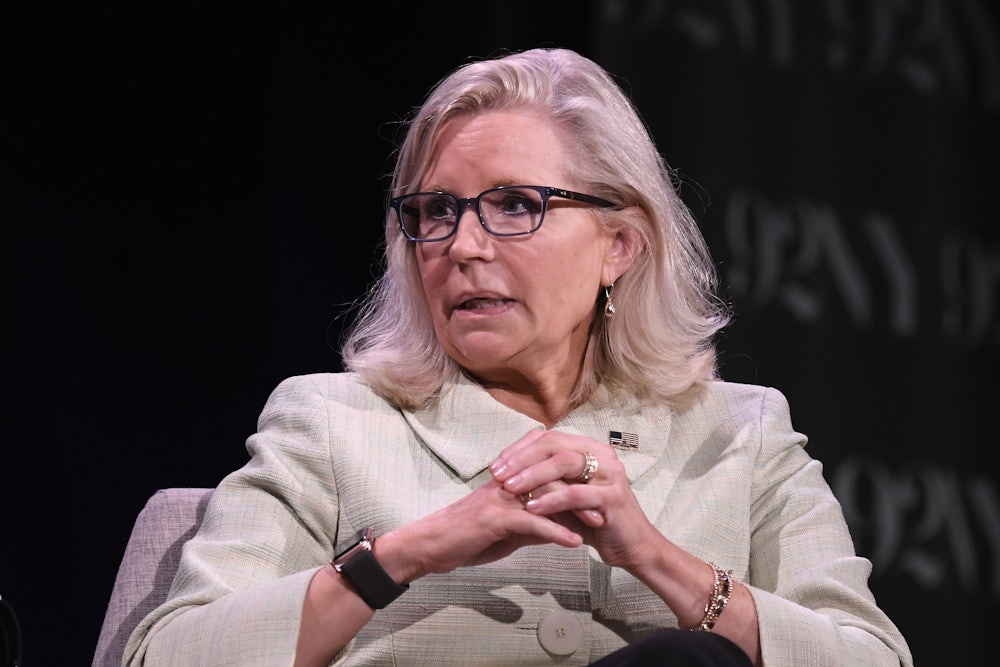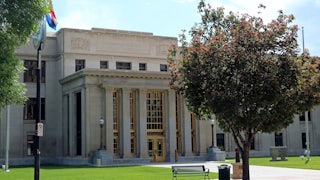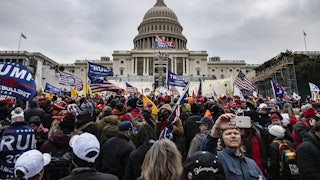If the Supreme Court takes its time in handing down a ruling on Donald Trump’s demand for absolute immunity for insurrection-related crimes, voters may not know whether Trump is a convicted criminal before deciding whether to elect him to the most powerful position in the world.
That’s bad enough. But there’s another dimension to all this that’s gone underappreciated: Such a delay could also perversely reward Trump and his allies for the extensive cover-up they implemented after the insurrection failed by denying voters critical information about Trump’s conduct on January 6, 2021. Even putting aside whether Trump’s coup amounted to criminality, keeping voters in the dark throughout the election about that conduct would represent an appalling, next-level failure of accountability.
This idea emerges from Liz Cheney’s new op-ed piece in The New York Times urging prompt action from the high court, which will hear arguments in the case this Thursday. Buried in the piece is an urgent warning whose importance is not immediately obvious. Cheney writes that a delay in this ruling could kick Trump’s trial until after the election, which we know. But then Cheney says special counsel Jack Smith obtained—and presented to the grand jury that indicted Trump—information that the House committee that examined Jan. 6, on which she served as vice chair, could not gain access to. Cheney adds this:
There is little doubt that Mr. Trump’s closest advisers also gave the federal grand jury minute-to-minute accounts of his malicious conduct on Jan. 6, describing how they repeatedly begged the president to instruct the violent rioters to leave our Capitol and how Mr. Trump refused for several hours to do so as he watched the attack on television. This historic testimony about a former president’s conduct is likely to remain secret until the special counsel presents his case at trial.
The idea that voters might be denied knowledge of Trump’s “minute-by-minute” conduct during the attack might not, at first glance, seem alarming. Surely we know everything there is to know about Jan. 6 already, right?
No, we don’t. Note that some of the top Trump advisers who directly interacted with him during the mob’s rampage (such as White House chief of staff Mark Meadows and social media guru Dan Scavino) defied subpoenas by the committee. That’s surely in part because testimony about Trump’s conduct that day would be extremely incriminating.
Meanwhile, others who did testify (such as White House counsel Pat Cipollone) invoked executive privilege to withhold some private communications with then-President Trump. Cheney writes that this ended up denying the committee crucial testimony that it sought.
But Cheney doesn’t go into detail about what that all testimony might have revealed, which is essential to understanding the situation we’re in here.
True, the Jan. 6 committee report tells us a lot. It recounts that while the mob assailed the Capitol, Trump sent his tweet attacking then-Vice President Mike Pence for failing to help sabotage the election, seemingly to incite more violence to intimidate or punish Pence. The report also notes that Trump snarled to then-GOP House Leader Kevin McCarthy that he approved of the rioters’ underlying cause of obstructing the election’s conclusion. It details that Trump refused to call off the rioters for hours.
But investigators wanted to know more.
Thomas Joscelyn, a senior Jan. 6 committee staffer and principal drafter of its final report, says more cooperation from Scavino, Meadows, Cipollone, and others would have produced a fuller picture of Trump’s conduct during the riot and in the lead-up to it. We know many Republicans and advisers begged Trump to calm his supporters, but we have scant insight into how he reacted beyond doing nothing for hours. What did he say about the riot as it raged?
That would shed light on Trump’s “full intent for the mob,” Joscelyn says, noting that there are a “few hours” where we still need to know “exactly what he said to people.” As Joscelyn told me: “Very few witnesses were willing to pierce that inner sanctum of Trump.”
Guess what: We already know Smith has obtained much more in that regard. ABC News’s Jonathan Karl has reported that Trump’s top advisers provided Smith with an “extraordinarily detailed description” of what Trump was doing while the rioters rampaged.
That’s not all. Karl also reported that Scavino in particular has provided evidence along these lines that is “vivid and damning.” So what might that look like?
Well, Joscelyn points out that Scavino would have closely monitored online activity among the most organized of Trump’s paramilitary supporters, which had already begun outlining plans for violence in advance of Jan. 6, after Trump sent his initial December 19 tweet urging supporters to descend on Washington. Scavino might know whether Trump had been briefed on these violent designs and what Trump said about them, Joscelyn says, which could reveal more about how Trump “stoked” the most “fervent, hardened base of Trump supporters.”
The Jan. 6 committee wanted to question Scavino about exactly this, among other things, but could not. Smith surely has done so.
All this information would presumably come out at trial, which considerably raises the stakes around a potential Supreme Court delay. Consider that those who deny that Jan. 6 was an insurrection often seek to create the impression that there were two separate narrative lines leading up to that day: the procedural coup, in which Trump sought to corrupt government officials at all levels to scuttle the official transfer of power, and the mob violence. In this telling, the mob wasn’t all that directed by Trump; it just got out of control, and wasn’t particularly motivated toward realizing any concrete project. Hence, no insurrection.
In reality, those narratives are part of the same story: Trump saw the mob violence as the weapon to complete the procedural coup once it had failed him on every other front. He incited and directed it toward that precise end.
The evidence that this was Trump’s intent is already very strong. But there may be even stronger evidence of it out there—evidence that Trump and his loyalists sought to keep buried but that Smith has amassed. Evidence that, depending on what the Supreme Court decides, voters may never hear.
It may be, as some have argued, that the Supreme Court struck the right balance between competing interests in picking this schedule. It’s also possible the high court will ultimately issue a ruling in time for the trial to proceed before the election.
But the sobering reality remains: Voters this fall may still end up being denied critical, revelatory information that goes directly to the heart of the full insurrectionary intent driving Trump’s plot to overthrow the U.S. constitutional order. There’s no sugarcoating this: It’s still absolutely possible that key aspects of the cover-up implemented by Trump and his loyalists could very well succeed.






